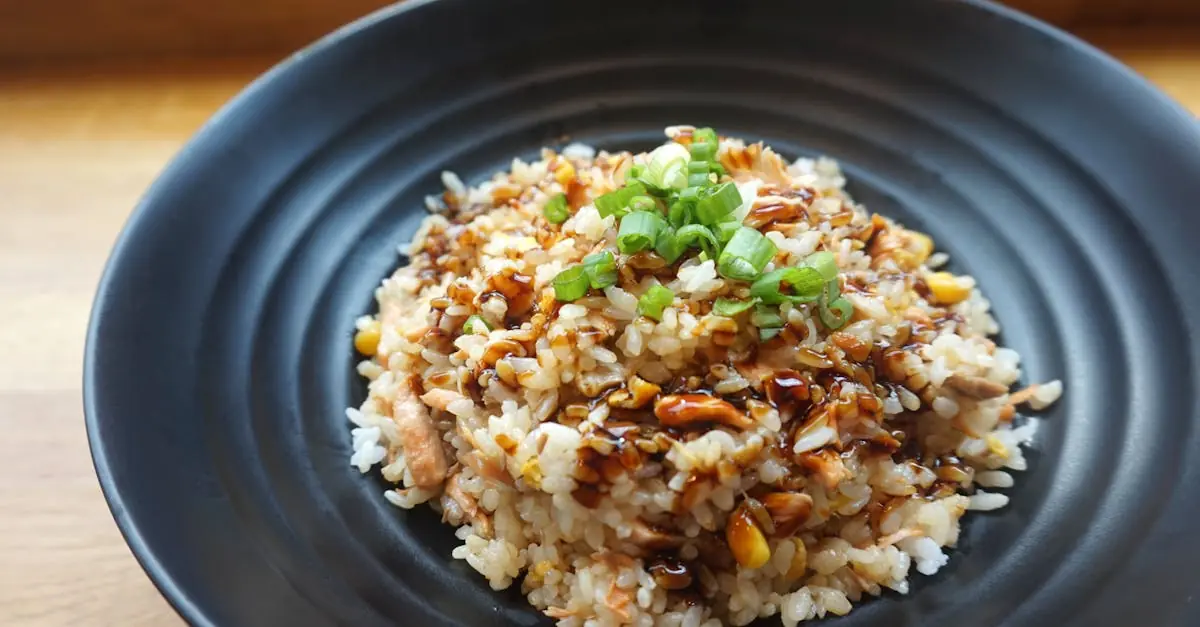A well-seasoned wok is like a culinary superhero, transforming ordinary ingredients into extraordinary dishes. But let’s face it: seasoning a wok can feel like trying to solve a Rubik’s Cube blindfolded. Fear not! With the right methods, anyone can master this essential skill and unlock the full potential of their stir-fry game.
Table of Contents
ToggleOverview of Wok Seasoning Methods
Wok seasoning involves several methods that create a non-stick surface and enhance flavor. Each method differs in approach but aims for similar results.
The traditional method utilizes heat and oils, providing a quick way to create a protective layer. First, heat the wok until it reaches a high temperature. Next, add a thin layer of oil, swirling it across the surface. Allow the oil to reach its smoking point, ensuring even coating and seasoning.
Another effective approach uses salt and cooking oil. This method starts similarly, with the wok heated on high. After reaching temperature, toss in a few tablespoons of salt, stirring for a couple of minutes. The salt aids in breaking down any impurities while combining with oil for seasoning.
A more modern technique incorporates oven seasoning. This begins with coating the wok in a thin layer of oil, similar to stovetop methods. After this, place the wok upside down in the oven at 400°F for an hour. This process allows even distribution and thorough seasoning.
Some cooks prefer to season their wok with natural ingredients. This can include garlic, ginger, or onions. Heating the wok and then sautéing these aromatic ingredients creates flavor depth and seasons the surface.
Several factors influence the choice of method. Experience level plays a role, with some preferring straightforward techniques while others explore more complex options. The type of wok also matters, as materials like carbon steel or cast iron respond differently to seasoning techniques.
Understanding these methods allows cooks to select the best technique for their needs, ensuring a well-seasoned wok for future stir-fries and other dishes.
Traditional Seasoning Techniques
Traditional seasoning techniques enhance the performance and longevity of a wok. Two primary methods include using oil and using salt.
Using Oil
Seasoning with oil establishes a non-stick surface critical for stir-frying. First, heat the wok on medium-high until it begins to smoke. Then, pour a small amount of high-smoke point oil, like flaxseed or vegetable oil, into the wok. Swirl the oil to coat the entire surface thoroughly. Ensure it reaches all edges, as this promotes even seasoning. After a few minutes, allow the oil to cool and wipe away any excess with a paper towel. Repeat this process several times for optimal results. This technique transforms the surface, giving it a dark, patina-like finish that improves cooking performance.
Using Salt
Using salt serves a unique role in wok seasoning. This method begins with heating the wok until it is hot. Next, add a generous amount of coarse salt to the pan, allowing it to toast lightly. Salt’s abrasive nature helps lift impurities and residues from the surface. Then, after a few minutes of stirring, remove the salt and wipe the wok clean. Following this, apply a thin layer of oil to maintain the seasoning. This technique not only cleans the wok but also prepares it for future use, enhancing the flavor of dishes cooked within.
Modern Seasoning Techniques
Modern techniques for seasoning woks can simplify the process while achieving optimal results. Two popular methods include oven seasoning and chemical seasoning.
Oven Seasoning
Oven seasoning offers a hands-off approach to creating a well-seasoned wok. This method starts with preheating the oven to 450°F (232°C). Once heated, he or she covers the wok’s interior with a high-smoke point oil. The oiled wok should be placed upside down on the oven racks. During the heating process, any excess oil drips off, ensuring an even layer coating the surface. After about one hour, letting it cool completely solidifies the seasoning, resulting in a durable, non-stick finish that enhances cooking performance.
Chemical Seasoning
Chemical seasoning involves using commercial products designed to create a non-stick surface. Products containing silicone or polymer compounds work effectively for this technique. Applying a thin layer of the product to the cleaned wok, he or she cooks the wok over medium heat until it reaches the necessary temperature listed in the product instructions. This method offers a quicker alternative, particularly for those new to wok seasoning. Using chemical options can easily maintain a non-stick surface, promoting better cooking results with minimal effort.
Common Mistakes in Wok Seasoning
Many people overlook the importance of cleaning the wok before seasoning. Failing to remove impurities can lead to uneven seasoning and a compromised cooking surface. Using the wrong type of oil can also hinder results. Opting for oils with low smoke points results in inadequate seasoning and flavor absorption.
Some cooks rush the heating process. Allowing the wok to reach the right temperature is crucial for effective seasoning. Another common mistake involves applying too much oil in a single step. This often creates a sticky surface instead of the desired non-stick finish.
Skipping multiple seasoning layers is a frequent error. A single coating usually doesn’t provide enough protection or flavor enhancement. Ignoring the storage conditions can affect seasoning longevity as well. Storing a seasoned wok in a damp environment can degrade the seasoning layer over time.
Relying solely on chemical methods is another pitfall. While they can provide convenience, they may not create as durable or flavorful a surface as traditional techniques. Not considering the type of wok also leads to inconsistencies in seasoning. Different materials respond uniquely to seasoning methods, impacting performance.
Finally, impatience can compromise results. Taking time to care for the wok through proper seasoning enhances its properties and cooking capabilities. Each step matters in creating a well-seasoned wok that delivers excellent results in various dishes.
Maintenance After Seasoning
Proper maintenance after seasoning a wok is crucial for longevity and performance. Regular cleaning prevents buildup that can affect cooking quality. Use warm water and a soft sponge for routine cleaning, avoiding soap, as it can strip the seasoning.
Drying the wok immediately after washing eliminates moisture, preventing rust formation. Heated cooling methods, like placing it back on the stovetop, aid in thorough drying. A thin layer of oil should be applied to the surface after drying, providing additional protection and enhancing non-stick properties.
Storage conditions play a significant role in maintaining a well-seasoned surface. Keep the wok in a dry, well-ventilated area, stored in a manner that prevents scratches or dents. Using a cloth or paper towel can cushion the surface when stacking with other cookware.
Addressing common pitfalls in wok maintenance ensures its effectiveness. Failing to dry the wok can lead to rust, while using abrasive scrubbers may damage the seasoning layer. Avoid overcooking or using high-heat methods immediately after initial seasoning, as it can degrade the protective finish.
Cooking techniques also influence maintenance. Consistent use of high-smoke point oils, such as canola or grapeseed, supports the integrity of the seasoning. Regular usage not only enhances flavors but helps maintain the seasoned surface.
It’s essential to re-season the wok periodically, especially if it shows signs of wear or rust. This ensures a non-stick surface remains intact, supporting efficient cooking for years. Prioritizing these maintenance steps contributes to a durable, flavorful, and well-performing wok.
Mastering wok seasoning is a journey that can significantly elevate one’s cooking experience. With a variety of methods available—from traditional oil and salt techniques to modern oven seasoning—cooks can find the approach that best suits their needs.
Understanding the importance of proper maintenance ensures that a well-seasoned wok remains in top form. By following best practices for care and re-seasoning, anyone can enjoy the benefits of a durable non-stick surface that enhances flavor and performance.
Investing time in seasoning and maintaining a wok pays off in delicious meals and improved stir-frying skills, making it a worthwhile endeavor for any culinary enthusiast.




